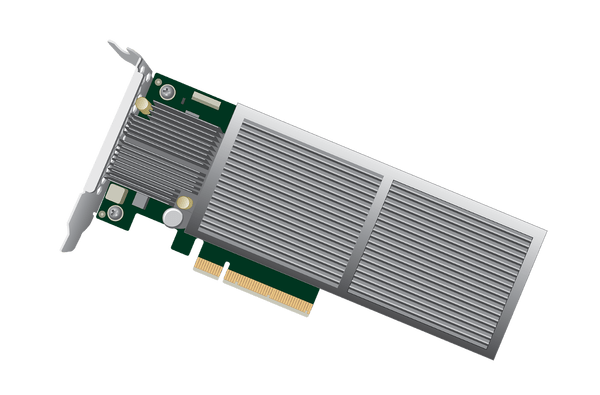
Seagate announced a new NVMe PCIe SSD at the Open Compute Project (OCP) conference that can attain up to 10 GBps of throughput. Seagate is not releasing many details of the new SSD, so we are not even sure if the 10 GBps is in sequential read or write throughput. One would imagine it to almost surely be sequential read access. 
There are no random performance specifications to speak of, but there are several very important aspects of the announcement. The first piece is that the standard SSD will come in PCIe 3.0 x8, and a Seagate proprietary adapter that houses four M.2 SSDs will offer x16 connectivity. The model featuring the x8 connection provides up to 6.7 GBps of throughput and 1 million IOPS, whereas the x16 model reaches the aforementioned 10 GBps. Seagate announced that the design is OCP-compliant, which will grant it access to the high-volume hyperscale market.
The move to PCIe 3.0 x8/x16 is important. The majority of today’s leading SSDs employ PCIe 3.0 x4 or PCIe 2.0 x8, which introduce throughput limitations that the new Seagate models easily surpass. The Intel DC P3608, one of the fastest SSDs to ever hit our lab, employs a PCIe 3.0 x8 connection, but its multi-controller architecture limits it to 4,839 MBps (by our measurement).
Many applications, such as database logging, data warehousing, HPC and content delivery networks, prize sequential throughput. Seagate’s new SSD will provide a tangible advantage in these workloads over competing devices and will also work well with large-scale cloud providers, web applications, weather modeling and statistical trends analysis.
The as yet unnamed Seagate scorchers also employ the NVMe interface, which is a lightweight protocol designed specifically for non-volatile memories. NVMe also affords broad compatibility with modern operating systems.
Seagate did not mention specific features of the new x8 SSD, but from the artist’s rendering, we spot what appear to be capacitors, which provide power-fail protection attributes. The two images also indicate that the x16 SSD will come in FHHL (Full-Height Half-Length) and the X8 will feature the HHHL (Half-Height Half-Length) form factor.
Seagate did not mention what type of controller it is employing on the new x8 SSD, but the company recently purchased SandForce. The exterior heatsink and design closely mirror the design employed with Seagate’s current line of SandForce-powered Nytro products. SandForce controllers utilize inline compression algorithms that boost performance and endurance, which is a powerful combination for almost any flash-based implementation.
The x16 model employs an array of four M.2 SSDs housed in an PCIe 3.0 x16 adapter, and while Seagate has not confirmed which M.2 SSDs it is employing, it is likely its recently announced Nytro XM1440 modules.
Micron also comes into the equation due to its strategic alliance with Seagate. The alliance, which was announced in February of last year, specifies that the two companies will collaborate on flash-based products and guarantees Seagate access to Micron NAND. The 12 GBps SAS Seagate 1200.2 and Micron S600DC were the first fruits of the strategic alliance and are identical in every aspect, including components and firmware. It would not be surprising if Seagate and Micron followed the same template with the new NVMe SSDs, and the new Seagate offerings will almost certainly employ Micron NAND.
The new unnamed Seagate SSDs, which we expect to carry the “Nytro” branding, will be available this summer. Seagate will have the new SSDs on display to prying eyes at the OCP Summit 2016 in San Jose, March 9-10.
[Source:- Tomsitpro]

